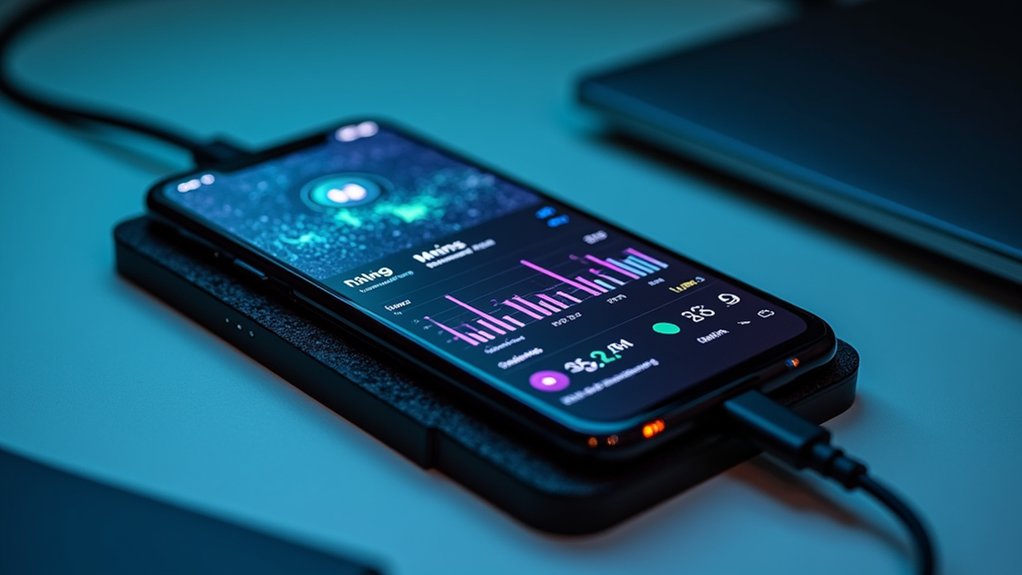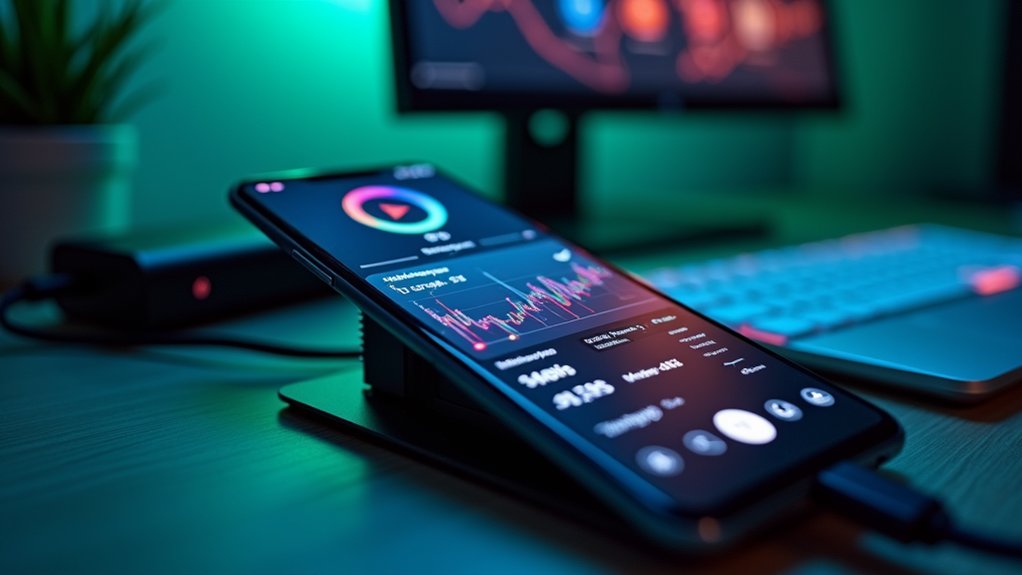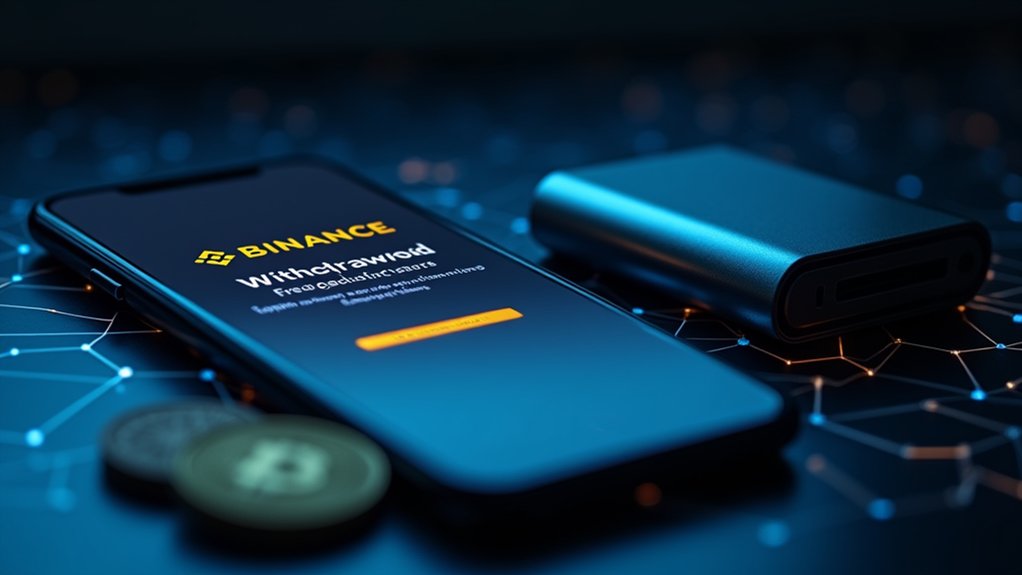Android cryptocurrency mining requires specialized applications that utilize either cloud-based systems or direct device processing power. Users can mine currencies like VerusCoin, Monero via CryptoTab, or participate in proof-of-stake networks like Pi Network. Implementing proper security measures, including permission management and hardware wallets, is essential for protecting earnings. To maximize efficiency while minimizing device strain, schedule mining during charging periods and connect to external power sources. The complete mining process involves additional optimization techniques for enhanced profitability.

Mining cryptocurrency on Android devices has progressed considerably in recent years, offering users multiple pathways to participate in blockchain networks without dedicated hardware setups. Modern applications have transformed to accommodate various mining styles, including cloud-based solutions that mitigate hardware strain, browser-based options that utilize idle processing power, and direct CPU/GPU utilization systems designed specifically for mobile architectures.
Mobile cryptocurrency mining now offers diverse options from cloud solutions to direct CPU utilization, making blockchain participation more accessible.
The technical landscape, while challenging for smartphone hardware limitations, now includes specialized applications like ECOS for cloud mining contracts with daily Bitcoin payouts, Kryptex for multiplatform mining utilizing mobile processors, and CryptoTab which converts Monero mining into Bitcoin rewards. Users should be prepared for significant battery drain when using these applications, as mining continuously utilizes substantial processing power. Understanding the smartphone limitations is crucial since mobile mining can lead to device overheating and potential damage with prolonged use.
The cryptocurrency selection available to Android miners has expanded beyond Bitcoin to include alternatives like Litecoin, Ethereum, and newer energy-efficient options like Pi Network with its proof-of-stake model. VerusCoin, specifically optimized for mobile CPU architecture, represents another viable option for Android users seeking to maximize returns from their devices. Successful Android miners often employ technical analysis tools similar to day traders to determine optimal times for mining specific cryptocurrencies.
The mining process typically follows a standardized implementation: users select a reputable application from trusted sources, configure mining parameters according to device capabilities, establish monitoring protocols, initiate the mining sequence, and withdraw earnings once minimum thresholds are satisfied.
Financial outcomes from Android mining operations remain modest compared to dedicated mining equipment, with older devices generating approximately $0.60 daily when mining VerusCoin. Cloud mining contracts through services like ECOS provide more consistent returns without the associated hardware deterioration, while game-based applications offer smaller rewards denominated in Satoshi units.
Security considerations necessitate thorough verification of application legitimacy through Google Play Protect, implementation of hardware wallets for cryptocurrency storage, and careful permission management to prevent unauthorized access. Technical optimization strategies should include external power sources to reduce battery degradation, scheduled mining during charging periods, and potential device modifications for users with advanced technical expertise.
Market fluctuations greatly impact potential returns, making Android mining more suitable for educational purposes or supplementary income rather than primary revenue generation.
Frequently Asked Questions
Is Mining Crypto on Android Profitable Compared to Desktop Mining?
Mining cryptocurrency on Android devices is demonstrably unprofitable compared to desktop mining operations, primarily due to severe hardware limitations.
Smartphones generate merely 37-40 H/s versus the millions achieved by ASIC miners, resulting in negligible weekly earnings of approximately $0.78.
Additionally, the intensive processing requirements accelerate battery degradation and device wear, creating additional costs that extend the break-even timeline to years, if not decades, making mobile mining economically unsustainable for serious cryptocurrency acquisition.
Will Crypto Mining Damage My Android Device Over Time?
Crypto mining on Android devices typically causes significant hardware degradation over time. The persistent high CPU/GPU utilization generates excessive heat, accelerating component wear, particularly battery degradation through repeated charging cycles.
Additionally, prolonged resource overconsumption leads to thermal throttling, reduced processing capabilities, and potential system failures. Most Android devices lack adequate cooling systems for continuous computational strain, resulting in shortened device lifespan, potential battery swelling, and permanent performance deterioration beyond manufacturer specifications.
How Much Battery Does Crypto Mining Consume on Android?
Cryptocurrency mining on Android devices typically consumes 70-90% of available battery capacity per hour, rapidly depleting power reserves through intensive computational processes.
The continuous operation of mining algorithms engages CPUs and GPUs at near-maximum capacity, generating significant heat while requiring approximately 3-5 watts of continuous power, which exceeds normal application consumption by 8-10 times and necessitates constant charging to maintain functionality.
Can I Mine While Using Other Apps Simultaneously?
Mining cryptocurrency while using other applications simultaneously is technically possible, though subject to several limitations.
Background mining apps, like Pi Network or cloud mining solutions, typically allow multitasking with minimal interference, whereas CPU/GPU-intensive mining operations greatly impair device performance.
Users should anticipate reduced mining efficiency, battery drain, thermal throttling, and potential memory conflicts when multitasking, with effectiveness largely dependent on device specifications and the specific mining application's resource management protocols.
Are There Legal Restrictions for Mobile Crypto Mining?
Legal restrictions for mobile crypto mining exist across multiple dimensions, varying notably by jurisdiction.
Miners must adhere to regional compliance requirements, including potential bans in locations like New York or China, tax obligations on mining income, environmental regulations that may restrict proof-of-work operations, and potential licensing requirements.
Additionally, evolving regulatory frameworks create compliance uncertainty, with some territories imposing AML/KYC obligations on miners or classifying them as money transmitters subject to financial oversight.









